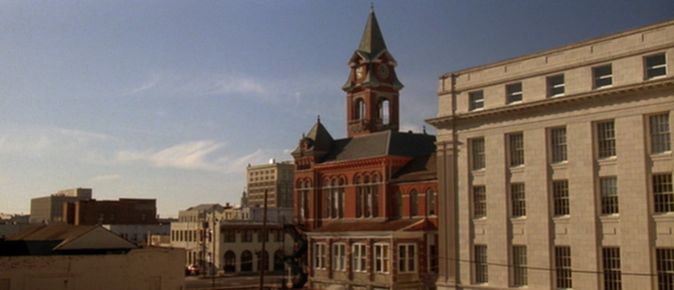 Back to selection
Back to selection
The Blue Velvet Project
Blue Velvet, 47 seconds at a time by Nicholas Rombes
The Blue Velvet Project, #6

Second # 282
An establishing shot of downtown Lumberton/Wilmington, showing the courthouse (from the back) in the mid foreground. In the previous shot, we have just seen Jeffrey for the first time as he walks through the field, wearing black. He stops, picks up a stone, and throws it as some junk. He then keeps walking, his back to the camera. At this point, we don’t know who he is or where he’s going. That shot is followed by this, at second #282, a static shot that lasts three seconds. When I began this project I wondered how frequently frames with no people in them would be among the 154 images. This is the third in a row, and the second static shot, with nothing happening in the frame and no camera movement. There is the motion in motion pictures, yes, but also static photographic moments, like this, where time is stretched and enlarged, and although approximately 72 frames have whirred through the projector in these three seconds (assuming, if we’re lucky, that we’re watching Blue Velvet in a theater) we feel as if we’ve been watching a still image. In her book The Emergence of Cinematic Time, Mary Ann Doane writes that during “the projection of a film, the spectator is sitting in an unperceived darkness for almost 40 percent of the running time. . . . Much of the movement or the time allegedly recorded by the camera is simply not there, lost in the interstices between frames.” (Here is a good discussion about this.) This notion of lost time, of time spent in the undetectable dark spaces of film itself, seems just right for Blue Velvet.
Over the period of one full year — three days per week — The Blue Velvet Project will seize a frame every 47 seconds of David Lynch’s classic to explore. These posts will run until second 7,200 in August 2012. For a complete archive of the project, click here. And here is the introduction to the project.
